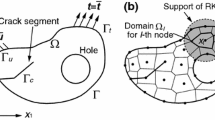Abstract
This paper summarizes the development of the surface integral and finite element hybrid method for two and three dimensional fracture mechanics analysis. The fracture, which is a discontinuity in the displacement field, is modeled explicitly and efficiently by use of dislocations for two dimensional analysis and by dipoles of point forces for three dimensional applications. The boundary value problem of a fracture in a finite domain is solved by (incremental) superposition of a finite element model of the finite body without the crack and a surface integral model of an infinite body with the crack, ensuring proper traction and displacement matching at the boundaries. Finite elements are also used to model nonhomogeneity and plasticity, though isotropic kernels are used for the integral equation. A variety of two and three dimensional problems have been modeled and excellent agreement with analytical solutions has been obtained. Propagation problems in two dimensions have also been modeled and the predicted results agree very well with experimental observations.
Résumé
On résume le développement de la méthode de l'intégrale de surface et des éléments finis hybrides pour l'analyse de la mécanique de rupture à deux et à trois dimensions. La rupture, considérée comme une discontinuité dans un champ de déplacement, est représentée de manière explicite et avec efficience en recourant aux dislocations dans le cas de l'analyse à deux dimensions, et aux dipoles de forces ponctuelles dans le cas des applications à trois dimensions. Le problème de la valeur aux limites d'une rupture dans un domaine fini est solutionné par la superposition par incréments d'un modèle à éléments finis d'un corps fini dépourvu de fissures et d'un modèle en intégrale de surface d'un corps infini pourvu d'une fissure, en s'assurant que les conditions appropriées de traction et de déplacement s'accordent aux limites. On utilise également les éléments finis pour représenter une non homogénité ou de la plasticité, bien que des kernels isotropes soient employés pour l'équation intégrale. On a représenté divers problèmes à deux et à trois dimensions et on a obtenu un excellent accord avec les solutions analytiques. Les problèmes de propagation en deux dimensions ont également été modélisés, et ces résultats prévus sont en excellent accord avec les observations expérimentales.
Similar content being viewed by others
References
B.S. Annigeri, “Surface Integral Finite Element Hybrid Method for Localized Problems in Continuum Mechanics”, Sc.D. thesis, Department of Mechanical Engineering, M.I.T., (April 1984).
B.S. Annigeri and M.P. Cleary, International Journal for Numerical Methods in Engineering (1984) 869–885.
B.S. Annigeri and M.P. Cleary, “Quasi-static fracture propagation using the surface integral finite element hybrid method”, presented at the ASME Pressure Vessels and Piping Conference, San Antonio, Texas, June 1984, See ASME PVP Vol. 85 or AMD Vol 61 (1984).
P.K. Banerjee and R. Butterfield, Boundary Element Methods in Engineering Science, McGraw-Hill, United Kingdom (1981).
D.T. Barr and M.P. Cleary, International Journal of Solids and Structures (1983) 73–82.
B.H.G. Brady, “A boundary element method for three-dimensional elastic analysis of tabular orebody extraction”, 19th U.S. Rock Mechanics Symposium (1978) 431–439.
M.P. Cleary, International Journal of Solids and Structures (1977) 785–806.
M.P. Cleary, International Journal for Numerical Methods in Engineering (1976) 679–702.
M.P. Cleary, M. Kavvadas, and K.Y. Lam, “Development of a fully three-dimensional simulator for analysis and design of hydraulic fracturing”, MIT UFRAC Report No. REL-82-12 (1982).
S.L. Crouch and A.M. Starfield, Boundary Element Methods in Solid Mechanics, George Allen and Unwin, London (1983).
T.A. Cruse and R.B. Wilson, “Boundary-integral equation method for elastic fracture mechanics analysis”, AFOSR-TR-0355 (November 1977).
M.K. Kassir and G.C. Sih, Mechanics of Fracture Vol. 2, Three-Dimensional Crack Problems, Noordhof International Publishing, Leyden (1975).
W.D. Keat and M.P. Cleary, “Development of surface integral finite element hybrid capability for the analysis of fractures in three dimensional bounded continua”, MIT UFRAC Report No. REL-84-6 (September 1984).
M.C. Lu and F. Erdogan, “Stress intensity factors in two bonded elastic layers containing cracks perpendicular to and on the interface — Part II Results”, NASA Report No. 159219 (January 1980).
V.M. Narendran and M.P. Cleary, Engineering Fracture Mechanics (1984) 481–506.
M.A. Pustejovsky, “Fatigue crack propagation in titanium under general inplane loading”, Ph.D. thesis, Aeronautics and Astronautics Dept., M.I.T. (1976).
M.A. Pustejovsky, Engineering Fracture Mechanics (1979) 9–15.
M.A. Pustejovsky, Engineering Fracture Mechanics (1979) 17–31.
Rongved, Proceedings of Second Midwestern Conference on Solid Mechanics (1955) 1–13.
H. Tada, P.C. Paris and G.R. Irwin, The Stress Analysis of Cracks Handbook, Del Research Corporation, Hellertown, Penn. (1973).
T.D. Wiles and J.H. Currant, in Proceedings of the 4th International Conference on Numerical Methods in Geomechanics (held at Edmonton, Canada), Vol 1, A.A. Balkema, Rotterdam, The Netherlands (1982) 103–111.
Author information
Authors and Affiliations
Rights and permissions
About this article
Cite this article
Keat, W.D., Annigeri, B.S. & Cleary, M.P. Surface integral and finite element hybrid method for two- and three-dimensional fracture mechanics analysis. Int J Fract 36, 35–53 (1988). https://doi.org/10.1007/BF00034816
Received:
Accepted:
Issue Date:
DOI: https://doi.org/10.1007/BF00034816




